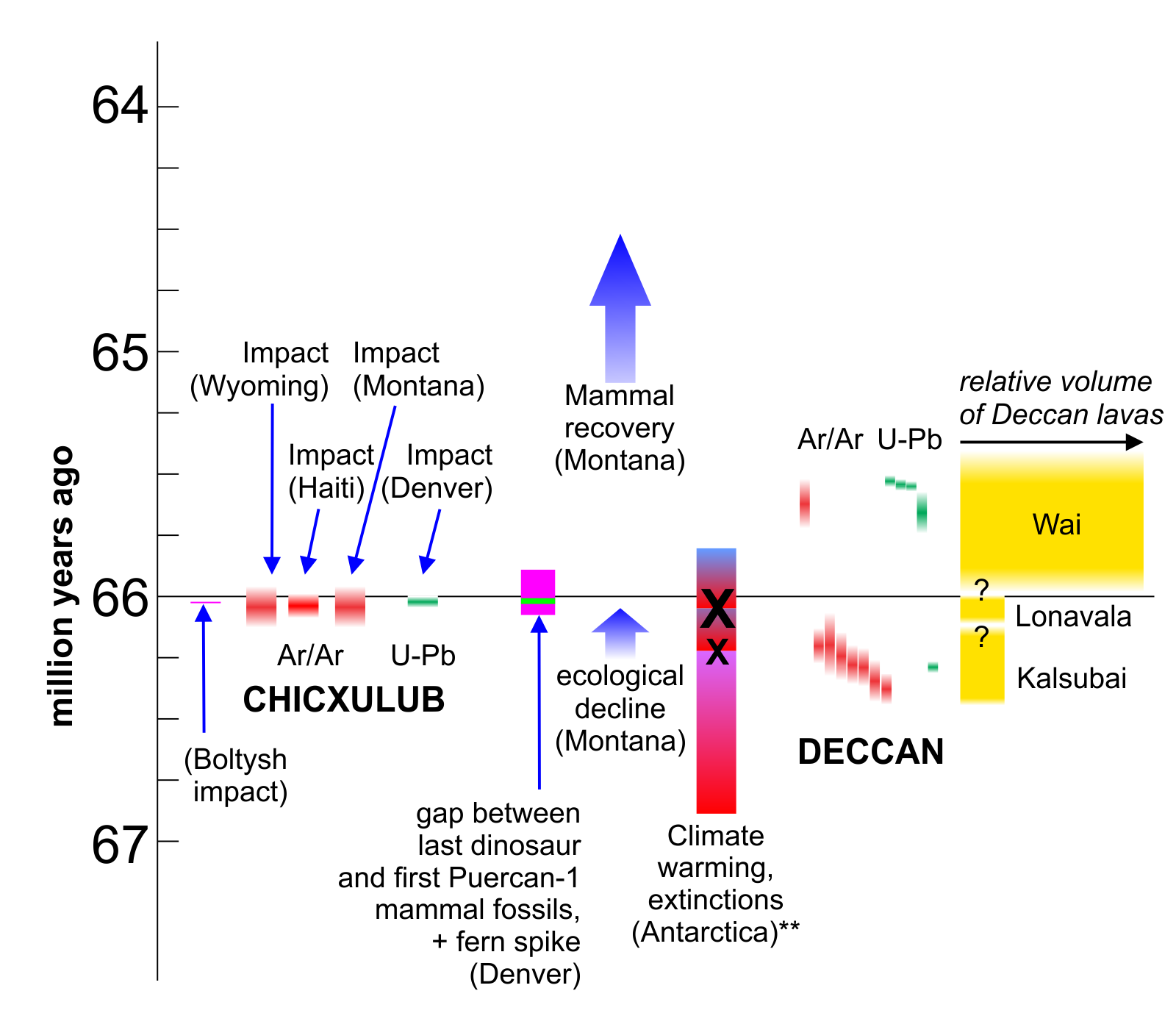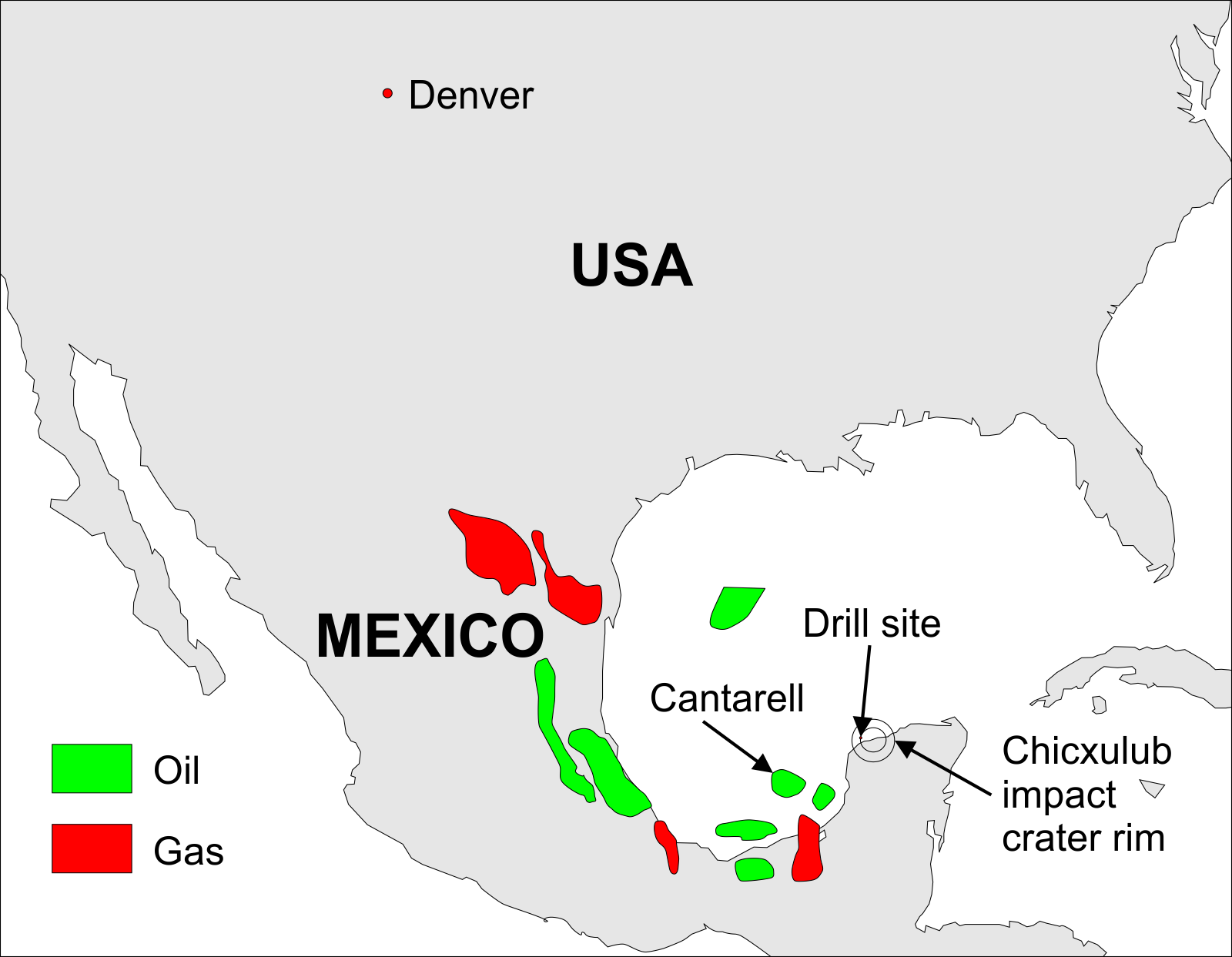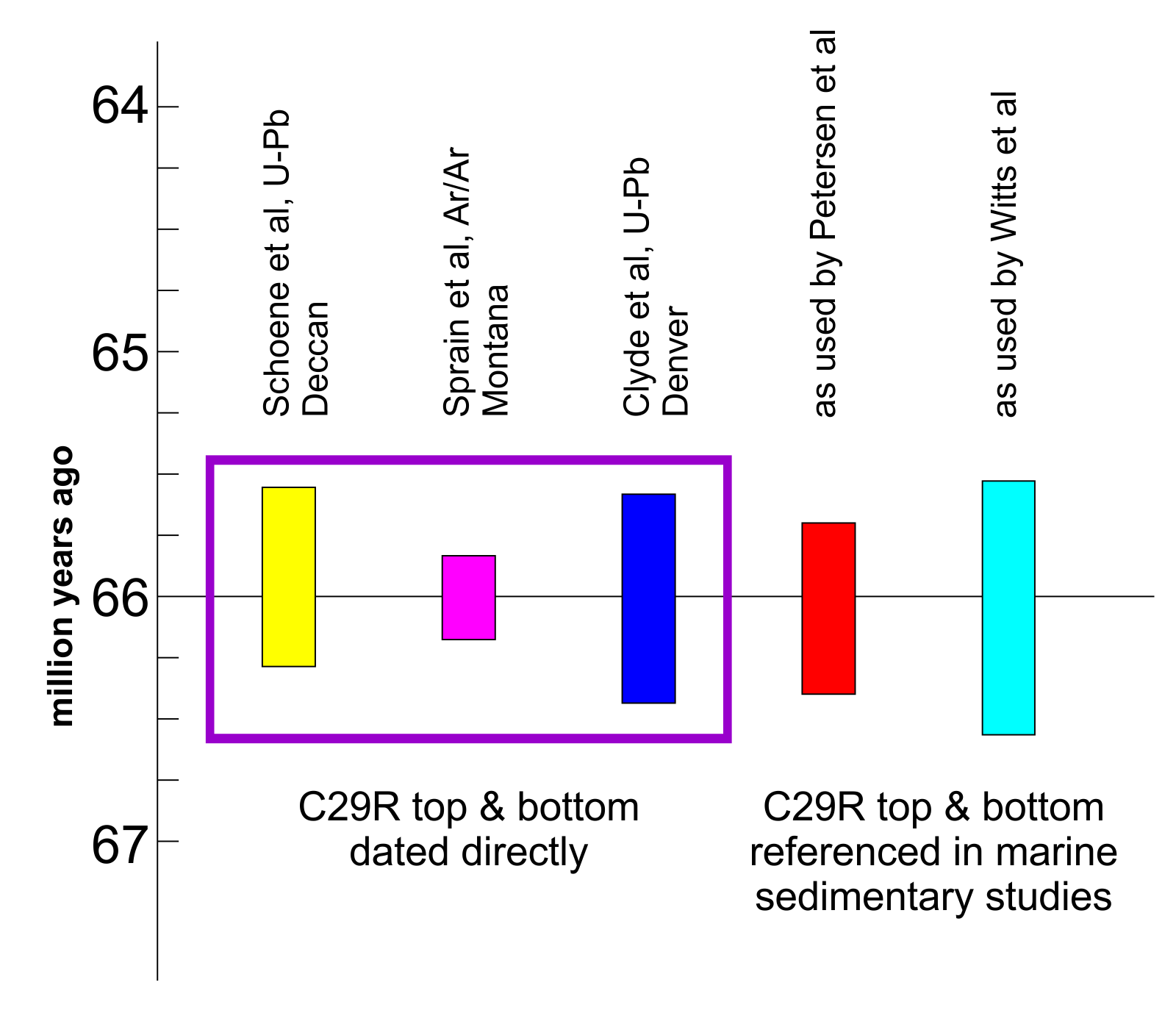So what did-in the dinosaurs? An update.
Posted on 19 January 2017 by howardlee
Of all the great mass extinctions, the end-Cretaceous is the only one credibly linked to an asteroid impact. It’s also the one that most people have heard about – the one that got the dinosaurs.

Most people accept that the asteroid impact at Chicxulub in Mexico caused the mass extinction, but in my article in early 2015, I showed that a number of scientists have cast doubt on the globally lethal impact of the Chicxulub impact, and that new rock dates had put the Deccan eruptions at just the right time to cause the extinction. This made the end-Cretaceous similar to all the other major extinctions ever since the evolution of animals (except the end-Ordovician extinction), which have been linked to the effects (including CO2-driven climate change) of massive volcanic eruptions from a rare geological phenomenon called a “Large Igneous Province” or “LIP.”
Since then, several papers have strengthened the case for the Chicxulub impact’s role in the extinction, and several others support the role of the Deccan eruptions, so the debate over what was the principal cause of the extinction, and how the killing was done, continues. Last year an international project drilled directly into the Chicxulub impact crater, and the first results are just beginning to emerge from that. There will be more to report in the months to come, but what follows is an update of some of the advances over the last two years in our understanding the end-Cretaceous mass extinction.
Synchronicity
Despite a 100-fold improvement in rock dating precision in the last 5 years, high-precision rock dating has not yet been able to separate either the Deccan eruptions or the Chicxulub impact from the extinction. In my 2015 article I outlined evidence, exposed in a Mexican hillside, that the extinction post-dated the Chicxulub impact by an estimated 100,000 years (without the benefit of high precision dates). New rock dates show that the Deccan eruptions persisted through and after the impact, straddling the extinction, and they all happened within a few tens of thousands of years of each other. This led to the idea proposed in 2015 by Richards et al (including Walter Alvarez, an author of the original impact hypothesis paper in 1980) that the impact actually triggered a much more vigorous phase of eruption in the Deccan Large Igneous Province.
I asked Joanna Morgan of Imperial College London, one of the scientists leading the Chicxulub Drilling project, about this in a Press Conference at the AGU Fall meeting in December. She didn’t give the theory much credence:
“So, whether the Chicxulub had anything to do with anything happening in the Deccan, there’s no really good reason to believe that’s the case. Seismic activity does induce volcanic eruptions so we do know that where there has been a big earthquake you get volcanic eruptions released, but to think the other side of the planet you could have some giant eruption because of the Chicxulub impact is just not particularly likely. People who try to model that treat the Earth as very homogeneous and then you can amplify your signal, where actually the Earth is very heterogeneous so [the signal] decays a lot more quickly than they predict. So, it might have caused some minor eruption but it would not have been of any significance relative to the Chicxulub impact itself.”

How it all lines up so far: Rock dating of Chicxulub impact (left), recently published information on terrestrial and marine extinctions (middle), and recent dates for Deccan lavas. Vertical ‘smear’ of dates depicts 1 sigma uncertainties including from systematic sources from published dates. **the timing of the climate warming in Antarctic waters and extinction events is probably much less certain since it relies in part on uncertain end-Cretaceous magnetostratigraphy. Ar/Ar = Argon/Argon radiometric dates, U-Pb = Uranium-Lead radiometric dates. Boltysh impact shown at 2-5,000 years before Chicxulub based on Jolley et al (2010). Wyoming and Haiti dates for impact traces from Renne et al (2013). Denver data from Clyde et al (2016). Montana data from Sprain et al (2015) Antarctic data from Petersen et al (2016), Deccan data from Renne et al (2015) and Schoene et al (2015).
Dating the extinction
Most scientists treat the layer of clay found in many parts of the world at the end-Cretaceous as the actual horizon of extinction because it contains impact traces (spherules, shocked quartz and high iridium levels), and it occurs in the gap between Cretaceous fossils and later Paleocene fossils, but this assumed equivalence has been criticized as “circular reasoning” by Professor Gerta Keller of Princeton.
Preliminary results from the Chicxulub drilling project presented at the AGU, however, do seem to support that synchronicity. The sediments immediately overlying the crater rim contain Cretaceous foraminifera fossils that were exhumed and redeposited, as well as foraminifera fossils from “disaster species” that specialize in severe environmental stress. These occur in the “settling layer” that formed in the (estimated) days to centuries following the impact. That same layer has a spike in nickel concentrations at its base. Nickel is used as a proxy for iridium, which is considered a diagnostic indicator of an asteroid impact. The more expensive iridium analyses will be done later on the layers with nickel anomalies.
The newest uranium-lead dates measured in rocks near Denver by Clyde et al, published last fall, also show that the fern spike (the layer which indicates most vegetation was replaced by ferns during the extinction) peaked about 85 years after the impact, and lasted roughly 850 years. That’s astonishingly precise for 66 million years ago, and so close in time to the impact as to be inescapably linked. A similar fern spike has also been found in end-Cretaceous rocks across much of North America, Japan and New Zealand, but not Alaska, Russia, China, or Antarctica.
Moreover, the last dinosaur fossil formed about 57,000 years before the impact, and the first Paleocene mammal fossils appear just 128,000 years after the impact horizon, as measured by Clyde et al.
Because not every dinosaur (or any other creature) will be fossilized after it dies, let alone be dug up by a paleontologist, scientists expect the last fossil of a species to predate its extinction, and the first fossil of a species to postdate the origination of that species (the “Signor-Lipps effect”). The fact that the last fossil of a large, rarely-fossilized land animal is found within 57,000 years of the impact is actually extremely close, and consistent with dinosaurs being extinguished by the impact.
So, on land 1,500 miles (2,400km) from the epicenter of the impact, the coincidence between impact and extinction seems clear.
But that’s not the whole story.
How could Chicxulub have killed on a global scale?
In their just-published survey of the causes of mass extinctions over geological time, Bond and Grasby state:
“…175 impact structures had been identified on Earth. Of these, only the Chicxulub crater is associated with a mass extinction, giving an impact/extinction ratio of 175:1, far greater than that of LIPs/extinctions. This renders the question: ‘can impacts cause extinction?’”
Of the impact kill mechanisms proposed, most accounts still refer to a heat flash and a global firestorm, but there’s very little evidence to support this. As Bond and Grasby point out, many end-Cretaceous sediment exposures lack charcoal despite containing non-charred organic matter. In my 2015 article, I mentioned experiments that showed the heat flash was unlikely to have been able to ignite global wildfires. These doubts have been around for a while - Joanna Morgan published a paper in 2013 pointing out the lack of evidence for global wildfires at the end-Cretaceous.
Goldilocks cooling
A more plausible kill mechanism by the Chicxulub impact is climate cooling (“Impact Winter”) caused by dust, sulfur aerosols, or even soot blasted into the stratosphere.
A paper by Kaiho et al published last summer points out that this cooling has to be a goldilocks kind of cooling – cold enough to kill off dinosaurs but not so cold as to kill off crocodiles! That’s a problem for severe cooling scenarios such as that proposed in the recent paper by Brugger et al, who model stratospheric sulfur aerosols generated by the impact causing 26ºC of global cooling, with subfreezing temperatures prevailing for 3-16 years before the climate recovers after 30 years.
Kaiho et al point out that this is too cold, and would have killed off not just the dinosaurs but also crocodiles and other animals that require warmer climates to survive. Instead, Kaiho et al invoke soot from burning crude oil.
The oil in the Cantarell field, one of largest in Mexico, is actually trapped within the rubble of the Chicxulub impact, but is derived from an older source that would have been present at the time of the impact. Large oil fields near Chicxulub suggest the impact could very well have incinerated large amounts of crude oil.

Location of oil and gas fields in relation to the Chicxulub crater, with location of 2016 drill site. Oil and gas field locations from comptroller.texas.gov
To support their case, Kaiho et al analyzed the chemistry of carbon molecules in the impact deposits from both Haiti and Spain. They found a distinctive combustion chemical called coronene, and glass spherules from the impact fallout, showing that the impact resulted in extensive combustion. Their analysis of alkanes in the impact layer shows those molecules were derived from both crude oil and dead organisms, but the alkanes in the layer deposited immediately after were sourced just from crude oil. They also found a 4-fold jump in cadalene, a chemical marker of dead higher plants, just below and in the iridium layer, indicating devastation of land plants. The presence of carbon cenospheres in end-Cretaceous rocks from Canada, Spain, Denmark, and New Zealand is further evidence for burning oil - carbon cenospheres are microscopic carbon-rich beads that form when coal or heavy fuel oil are heated intensely.
Kaiho et al’s modeling suggests about 1.5 billion metric tonnes of soot was blasted into the stratosphere by the impact, enough to cool surface waters by 3-10ºC within 2-5 years after impact, before temperatures recovered over a decade or so. They hypothesize that cooler temperatures killed off land life at high latitudes, while an ensuing drought drove tropical land life to extinction. The authors also think soot-contaminated ocean water may have blocked sunlight, choking off photosynthesis at the base of the food web. Surface water cooling and reduced photosynthesis would have driven shallow-living species extinct, but not so many deeper-living creatures. They also find that the soot would not have caused global darkness so often portrayed as a consequence of the impact.
So, perhaps, the freak coincidence of an impact into an oil field created the unique lethality of Chicxulub compared to other documented impacts. There also appears to be something unique about the kinds of species that went extinct. Jonathan Payne presented data in the AGU meeting last December that suggested the pattern of extinction for the end-Cretaceous was different from the other major mass extinctions, except for the end-Ordovician. Interestingly, climate cooling has been suggested as the driver for both.
But that doesn’t mesh with clear signs of global warming around the same time, and traces of volcanic pollution found in sediments marking the extinction, which are similar in several other mass extinctions blamed on LIPs.
Deccan eruptions and climate change
Petersen et al measured a rapid 8ºC jump in seawater temperatures using sediments from Seymour Island in Antarctica, at the same time as massive CO2 emissions from the Indian Deccan Traps eruptions (“rapid” here means anything less than about 30,000 years, possibly centuries, such are the limits of time resolution). They also found a second, smaller spike in warming about 150,000 years later, at around the same time as the Chicxulub impact. Each climate warming spike correlates with an episode of extinction identified in an earlier study led by Professor Tobin of the University of Alabama (represented by an “X” in the figure above).
CO2 levels just before the end-Cretaceous extinction were around 570ppm. Limited data suggest there may have been a very large increase in CO2 levels right at the extinction, raising CO2 levels to at least 2,300 ppm, sufficient to warm the planet abruptly by 7.5ºC, matching Petersen et al’s results. By the early Paleocene, the climate had cooled and CO2 levels were down at around 310ppm. Recent modelling shows that CO2 from the Deccan could have caused the warming measured in the sediment temperature proxy records, but that rock weathering rates must have been enhanced to achieve the Paleocene cooling observed.
According to Petersen et al:
“the rate of warming, as opposed to the maximum temperatures reached, led to extinction. The rate of warming during the Deccan temperature spike appears to be more rapid than at any other temperature change seen in the record”
Two episodes of warming at the end-Cretaceous have also been reported in Tunisian rocks, in a 2016 study by Thibault et al, who also found a “weak” extinction associated with the Deccan eruptions. But the paper by Witts et al, who studied the same location as Petersen et al, found no signs of environmental stress before a single “rapid” extinction event, with fossils disappearing a few tens of thousands of years before the impact (this predating is explained by the Signor-Lipps effect again). Witts et al also found a broad global warming signal that ended before or at the impact.
But the fundamental problem with trying to match those marine studies with the impact and the eruptions is the lack of precision in the dates of the marine studies. Marine sediments are typically dated and correlated using a combination of age-specific fossil assemblages, fossilized magnetic field reversals (magnetostratigraphy), orbital cycles, and isotope curves. These just can’t match the precision now being delivered by high-precision rock dating, which leaves quite a bit of wiggle room when attempting to tie down the exact point in a marine sediment record when the impact, or the eruptions, occurred.
It’s not helped by the fact that the timing of the magnetic field reversal that brackets the end-Cretaceous, C29R, has varied by as much as 707,000 years in recent publications, roughly the duration of the Deccan eruptions. The problem is made worse by burrowing marine creatures, which mix up sediment layers smearing any signal, as recently documented for the end-Cretaceous iridium signal in New Jersey sediments, and by percolating fluids, as documented offshore Newfoundland.

Variable measuring stick: variations in the published dates of magnetostratigraphic Chron 29 R complicate linking marine records of extinction, climate signals, the Chicxulub impact, and the Deccan eruptions.
Volcanic pollution traces at the end-Cretaceous boundary
In light of that uncertainty, it would be useful if a direct trace of the eruptions could be found in those marine sediments. New data suggest it can.
Sial et al published data last summer showing the presence of unusual levels of mercury in end-Cretaceous sediments from Denmark, Italy, India and Argentina. They found 3 spikes of mercury: before, at, and above the end-Cretaceous boundary layer. They also studied the ratios of different isotopes of mercury and found that the mercury came from volcanic eruptions, not asteroids, and that it had traveled a long way in the atmosphere (ie from large, distant eruptions). High mercury levels have also been found in end-Cretaceous sediments in France, starting below and continuing above the end-Cretaceous boundary layer. The combination of high mercury levels with iron oxide dissolution, suggesting acidification, and the presence of a mineral called “akaganeite,” a rare iron chloride mineral formed at some volcanic vents, all in the same layer, suggests a volcanic signal in the extinction layer.
High levels of mercury are considered to be a fingerprint of Large Igneous Province eruptions and have also been measured for the end-Triassic and Permian, suggesting that toxic metal loading could be a kill-mechanism in addition to climate effects and ocean acidification.
The mercury levels in the extinction layer sediments around the planet are a clear signal of the Deccan eruptions at the time of the extinction, apparently preceding and outlasting the impact.
High iridium levels are normally accepted as diagnostic for asteroid impacts due to iridium’s low abundance in Earth’s crust, but very high iridium levels have been measured in vents of hot-spot volcanoes in the Indian Ocean and Hawaii. Hot-spot volcanoes have the same mantle-plume origins as LIPs like the Deccan, so this raises the possibility that the iridium, like the mercury, might also come from a LIP source.

So where are we now?
It’s complicated.
In an email conversation last year, Sierra Petersen said:
“Our findings support the ‘press-pulse’ extinction mechanism. The volcanism caused significant climate change, and the environmental stress from this climate change likely led to enhanced overall extinction.”
Or, as Sial et al state:
“We hope this study contributes to the growing agreement that a single large asteroid/comet impact could not have been the sole cause of the end-Cretaceous mass extinction, but rather a contributing factor along with volcanism.”
Hopefully new dates from the Chicxulub drilling project, and the Deccan lavas, along with tighter constraints on the date of the mass extinction on land and in oceans, and tighter dating of the climate upheavals, will bring much-needed resolution to this most ancient of murder mysteries.
It’s not just a matter of curiosity. That knowledge will help our understanding of the long-reaching effects of modern climate change. Bond and Grasby sum it up this way:
“The Cretaceous-Paleogene extinction is, of course, the most recent of Earth's great mass extinctions. However, Earth now faces challenges from anthropogenically-induced environmental changes that have been implicated in most, if not all, of the biocrises [in past mass extinctions].”
Citations:
Earth Impact Database, 2017. <http://www.unb.ca/passc/ImpactDatabase/> (Accessed: 2017, Jan 10)































 Arguments
Arguments






























I have been reading about this issue since it first became a hot topic (having walked into the caldera of Vesuvius in my early twenties sparked an interest in geology on top of interest in palaeontology since early years) and have pondered more recently on maybe the Chicxulub event triggered an eruption event on the other side of the globe seeing as the Deccan planes are almost opposite on the globe at a similar latitude.
Maybe it is a silly idea, but...
Lionel@1: perhaps more relevant is the thought that 65 million years ago the Deccan area would have been further south, possibly significantly, directly opposite where Mexico was. The shock waves of a massive impact may attenuate as they spread out but converge on the other side of the planet.
...just a thought?
Lionel A @1, the idea is not at all silly, and some research has been conducted into the possibility. A recent paper states:
As the emphasised sentences highlight, the eruptions associated with the Decan Traps started well before the Chicxulub impact, but that impact may well have significantly increased the lava flows at a later stage.
I found this article very interesting. It seems to me that scientists are obtaining new data from new scientific methods. Hopefully in a few years you will be able to write that the new data has all fit together and the solution explains the observed data.
If the Decan Traps turn out to be the primary cause of Dinosaur extinction it will be the second time in my life that this major point has been changed. This shows to me that scientists accept new explainations when new data is obtained.
Thanks, Howard Lee, for a truly interesting article. I'm looking forward to future episodes of this fascinating story.
Lionel.
Adding to Tom C's comment. The Author list for that paper he links to includes Walter Alvarez. It was he and his father Luis who first put forward the idea of the impact.
85 years! Is this a typo?
martin - no that's not a typo. From Clyde et al:
"Using the median sediment accumulation rate of 142 yrs/cm ... indicates that the ∼0.6 cm ... in stratigraphic thickness between the top of the K–Pg boundary layer and the peak in fern spore abundance... represents ∼85 yrs and the ~6cm thick recovery interval after the initial peak in fern abundance lasted ∼850 yrs, suggesting the entire fern spike occurred over ∼1000 yrs."
Theres more detail and discussion of uncertainty in the paper, but no it's not a typo.
An overlooked factor in this late K extinction event is the loss of atmospheric pressure that began at the end of the K superchron and would have been enhanced with the Chicxulub event. The isotope data from amber (Tappert 2013) indictes that the air pressure in the Upper K was about 1.7 times the present - N15 records also indicate a loss of N2 during the geomagnetic reversals. Certainly all proxy CO2 values that relate to temperature should be quoted as "ppm equivalent at 1 bar" and not simply ppm, as molecular pressure is, of course, a function of air density.
This is presented at length on Researchgate under "Giant Bugs, Martian Air, Pterosaurs and Ice Ages" .
BTW
The Deccan traps pale incomparison to the basalt flows in the pacific plateuax during the K and Eocene/Miocene periods: a probable source for the apparent increase in N2 and possibly for CO2.
[PS] It really helps discussion if you provide a proper citation for papers (like Tappert 2013) or better still, use the link tool to access a public copy. Is this the one you mean? I have added a link to the researchgate paper, but please learn how to do this yourself with the link tool in the comment editor.